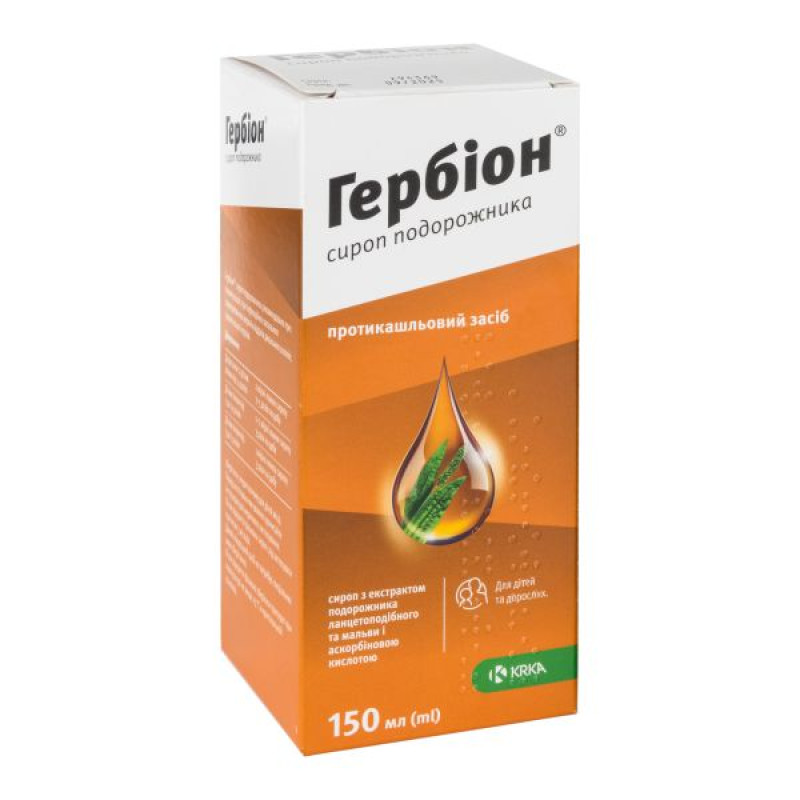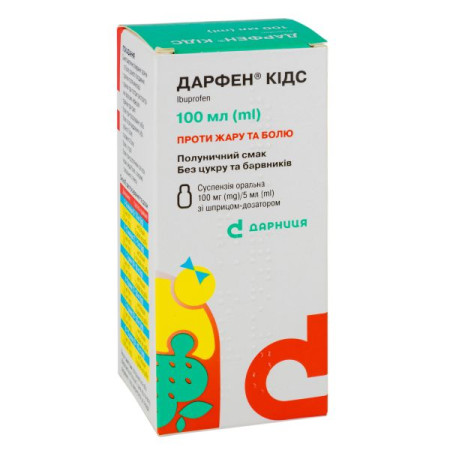Herbion Plantain syrup bottle 150 ml

Instructions for Herbion Plantain syrup, 150 ml bottle
Composition
active ingredient: liquid extract of plantain leaves and mallow flowers, ascorbic acid;
5 ml of syrup (1 measuring spoon) contains liquid extract (extractant – water) of plantain leaves (Folium Plantago lanceolata Lsl) and mallow flowers (Flos Malvasylvestris L.) 2.50 g; ascorbic acid – 65 mg;
excipients: sucrose, methyl parahydroxybenzoate (E 218), orange oil flavoring.
Dosage form
Syrup.
Main physicochemical properties: brown or reddish-brown syrup with a specific odor and taste. A slight precipitate is possible, typical of natural substances.
Pharmacotherapeutic group
Medicines used for coughs and colds. ATX code R05X.
Pharmacological properties
Pharmacodynamics.
Herbion® plantain syrup contains an extract of a mixture of plantain lanceolate leaves, mallow flowers, and ascorbic acid.
It is assumed that the gluten of plantain leaves and mallow flowers and the iridoid glycosides (aucubin) of plantain leaves play an important role in the action of the drug. Since the syrup contains gluten extracts, it acts as a mucolytic agent in dry irritating coughs that accompany inflammation of the upper respiratory tract. The mucolytic substance forms a thin protective layer on the mucous membrane of the oral cavity and throat and mechanically protects the mucous membranes from irritants that cause the cough reflex. Thus, it reduces cough caused by irritation of the mucous membrane of the respiratory tract during inflammatory processes caused by various environmental irritants.
Ascorbic acid is involved in many metabolic processes in the body; it stimulates the body's immune response and promotes cell regeneration.
Pharmacokinetics.
No studies on the absorption, distribution and metabolism of both active substances in the syrup have been conducted due to the lack of clarity as to which active substance contributes to the effect and to what extent.
The gluten polysaccharides of both preparations are not absorbed or converted, but act on the mucous membrane as a protective layer.
Absorption of ascorbic acid begins through the mucous membranes of the oral cavity and continues in the duodenum and small intestine. It is distributed to all tissues and cells. In the human body, ascorbic acid is reversibly oxidized to oxalic acid and ascorbate-2-sulfate, which are excreted in the urine. Excess ascorbic acid is excreted in the urine unchanged.
Indication
Dry cough in infectious and inflammatory diseases of the upper respiratory tract;
dry cough of smokers.
Contraindication
Hypersensitivity to the active substances or to any of the inactive components included in the composition of the medicinal product. Urolithiasis. Gastroesophageal reflux disease, including reflux esophagitis, gastritis with high acidity, gastric and duodenal ulcers. Severe kidney disease.
Interaction with other medicinal products and other types of interactions
The leaves of the plantain are lanceolate, and the flowers of the common mallow are similar.
Unknown.
Ascorbic acid.
Concomitant use with aluminum-containing antacids may increase urinary aluminum excretion. This combination is not recommended, especially in patients with a history of kidney disease.
Ascorbic acid increases iron absorption.
Concomitant administration with deferoxamine promotes iron excretion. The use of high doses of ascorbic acid in patients receiving deferoxamine may cause cardiac disorders (such as cardiomyopathy and congestive heart failure). In this combination, the daily dose of ascorbic acid should not exceed 200 mg; careful monitoring of cardiac function is recommended. Ascorbic acid should not be used in patients with heart failure receiving deferoxamine. Do not use ascorbic acid during the first month of treatment with deferoxamine.
High doses of ascorbic acid (1 g) inhibit the disulfiram-alcohol reaction in patients with alcoholism undergoing disulfiram treatment.
Ascorbic acid reduces the absorption of amphetamine due to its effect on gastric pH.
Ascorbic acid increases the total clearance of ethyl alcohol.
High doses of ascorbic acid impair the renal excretion of mexiletine due to changes in urinary pH. Patients should be carefully monitored when mexiletine and high doses of ascorbic acid are used concomitantly.
High doses of ascorbic acid may affect urine pH and increase the risk of crystalluria during treatment with sulfonamides.
Application features
Herbion® psyllium syrup contains sucrose, therefore it is not recommended for people with diabetes.
If shortness of breath, fever, purulent sputum, bloody sputum appear, or if symptoms worsen during treatment, you should seek medical advice.
High doses of ascorbic acid increase the excretion of oxalates in the urine, thus increasing the risk of oxalate stone formation in the urine. The risk is extremely low in healthy patients, especially when using less than 1 g of ascorbic acid per day. In urolithiasis and hyperoxaluria, the daily dose of ascorbic acid should not exceed 1 g, taking into account nutrition and dietary supplements.
When using ascorbic acid in large doses, kidney function should be monitored. Patients with a history of kidney disease should use the drug with caution, taking into account the vitamin C content in foods and food supplements.
Use with caution in patients with glucose-6-phosphate dehydrogenase deficiency.
Vitamin C in high doses should not be prescribed to patients with increased blood clotting, thrombophlebitis, and a tendency to thrombosis.
Since ascorbic acid increases iron absorption, its use in high doses can be dangerous for patients with hemochromatosis, thalassemia, polycythemia, leukemia, and sideroblastic anemia. Patients with high iron levels in the body should use the drug in minimal doses.
Ascorbic acid may affect the results of laboratory tests, for example, when determining the content of glucose, bilirubin, transaminase activity, lactate dehydrogenase.
Special information about excipients
Herbion® psyllium syrup contains sucrose. Therefore, patients with rare hereditary conditions of fructose intolerance, glucose-galactose malabsorption or sucrase-isomaltase deficiency should not take the drug.
Methyl parahydroxybenzoate (E 218) may cause allergic reactions (possibly delayed).
Use during pregnancy or breastfeeding
Since the safety of the drug during pregnancy or breastfeeding has not been established, the use of the drug during this period is not recommended.
There are no data on the effect on fertility.
Ability to influence reaction speed when driving vehicles or other mechanisms
There are no data on the effect of the drug on the ability to drive vehicles or other mechanisms.
Method of administration and doses
Adults and children over 14 years of age should be given 2 measuring spoons of syrup 3–5 times a day. Children aged 7 to 14 years should be given 1–2 measuring spoons of syrup 3 times a day.
Children aged 3 to 7 years should be given 1 measuring spoon of syrup 3 times a day.
The duration of the course of treatment is determined by the doctor individually.
If symptoms do not disappear after 1 week of use, you should consult a doctor for further therapy.
Patients should not eat or drink immediately after taking the drug, as food and drinks may accelerate the elimination of the drug from the mucous membranes of the mouth and throat.
The syrup should be shaken well before use.
During the period of using the syrup, it is recommended to drink plenty of tea or other warm drinks.
Children
The syrup is not recommended for use in children under 3 years of age without prior consultation with a doctor.
Overdose
There have been no reports of any cases of overdose.
Ascorbic acid is well tolerated. It is a water-soluble vitamin, excess amounts are excreted in the urine. Overdose may lead to changes in renal excretion of ascorbic and uric acids during urine acetylation with the risk of oxalate stone formation. The use of large doses of ascorbic acid may cause stomach pain, heartburn, vomiting, nausea or diarrhea, which disappear after discontinuation of the drug. Treatment is symptomatic.
If the recommended doses are significantly exceeded (the dose of vitamin C exceeds 1 g per day), renal failure, sleep disturbances, feeling of heat, fatigue, zinc and copper metabolism disorders, increased excitability, erythrocytopenia, neutrophilic leukocytosis are possible. With prolonged use of ascorbic acid in high doses, inhibition of the function of the insular apparatus of the pancreas is possible, therefore it is necessary to monitor its functional capacity. When using ascorbic acid in high doses, blood pressure control is necessary due to its stimulating effect on the formation of corticosteroid hormones.
Treatment is symptomatic.
Adverse reactions
On the part of the immune system: hypersensitivity reaction (itching, urticaria, eczema), angioedema, anaphylactic shock.
Methyl parahydroxybenzoate (E 218) may cause allergic reactions (possibly delayed).
From the nervous system: headache.
On the part of the kidneys and urinary system.
When using ascorbic acid in doses exceeding 1 g per day, oxaluria, kidney stone formation, and damage to the renal tubules can occur.
From the blood system.
The use of ascorbic acid in doses exceeding 1 g per day in patients with glucose-6-phosphate dehydrogenase deficiency may cause hemolysis of erythrocytes (hemolytic anemia).
If severe side effects occur, treatment should be discontinued.
Expiration date
3 years.
After opening the bottle, the syrup should be used within 3 months.
Storage conditions
This medicine does not require any special storage conditions.
After opening the bottle, store the drug at a temperature not exceeding 25 °C in the original packaging.
Keep out of reach of children.
Packaging
150 ml of syrup in a bottle together with a plastic measuring spoon in a cardboard box.
Vacation category
Without a prescription.
Producer
KRKA, dd, Novo mesto, Slovenia.
Location of the manufacturer and address of its place of business.
Smarjeska cesta 6, 8501 Novo mesto, Slovenia.
There are no reviews for this product.
There are no reviews for this product, be the first to leave your review.
No questions about this product, be the first and ask your question.











